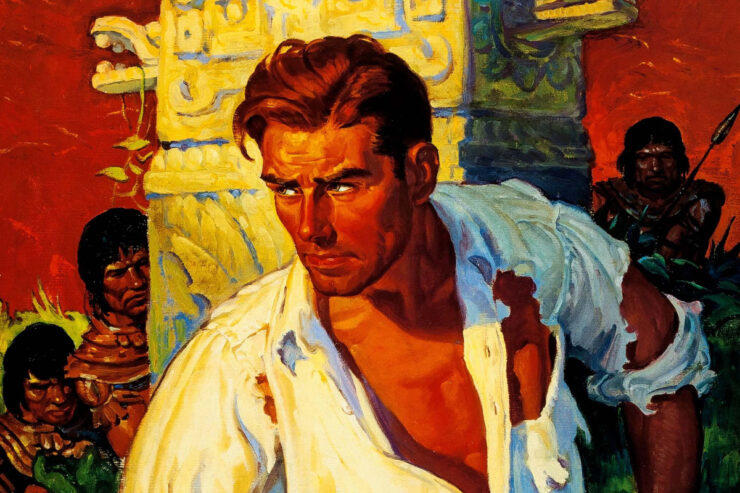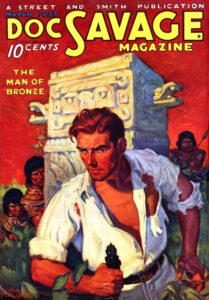 Street & Smith’s Doc Savage Magazine hit the nation’s crowded newsstands in an issue dated March 1933.
Street & Smith’s Doc Savage Magazine hit the nation’s crowded newsstands in an issue dated March 1933.
Graced with a Walter M. Baumhofer cover and a whiplash adventure story that moves from Manhattan to a lost Mayan City, the magazine and its hero arguably set the template for Superman and countless comic book superheroes that followed.
Doc, or more formally, Dr. Clark Savage, Jr., was Street & Smith Publications’ triumphant attempt to build on the “hero pulp” trend they had triggered with the highly successful and, eventually, twice-monthly The Shadow.
Indeed, 1933 saw a boatload of such hero pulp titles launched, including The Spider, The Phantom Detective, Pete Rice, Nick Carter, and G-8 and His Battle Aces, among others.
But Doc outlasted all of these, several by many, many years, or in the number of issues published. Doc Savage’s pulp run spanned 181 issues. A rejected novel by primary Doc author Lester Dent was recovered in the late 1970s by Will Murray and published in paperback by Bantam Books under the title The Red Spider in 1979.
While The Shadow was a mysterious and rather violent éminence grise who leaned harder on his network of agents and the occasional proxy hero, Doc Savage was very much a public figure heralded for his unrivaled mastery of a dizzying array of trades and skills, but most notably in the medical profession, earning him his nickname.
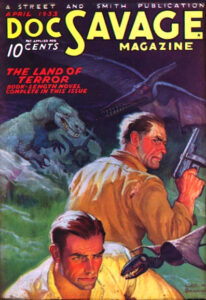
A bronze-skinned, golden-eyed giant, Doc Savage was created in-house by Street & Smith business manager Henry W. Ralston and editor John L. Nanovic, who more or less plotted the first novel in a kind of unofficial series bible.
After a test run at penning a Shadow novel, the writing chores for Doc were handed off to Missouri-born author and former telegrapher Lester Bernard Dent, writing under the house name of “Kenneth Robeson.”
Following a couple of uncharacteristically violent revenge tales (in the first novel, The Man of Bronze, Doc is working to solve the murder of his father; in the second, The Land of Terror, he investigates the ghoulish killing of a beloved mentor), Doc begins an evolution away from guns, relying more on merciful gadgets, his wits, and his sometimes blood-thirsty team of aides, whom Doc frequently refers to as his “brothers.”
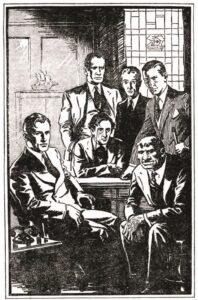 These include the huge-fisted, civil engineer, “Renny” Renwick; sickly-looking electrical wizard “Long Tom” Roberts; Harvard-trained lawyer “Ham” Brooks; Ham’s eternal frenemy, the industrial chemist “Monk” Mayfair; and the gaunt and tall archaeologist and geologist, “Johnny” Littlejohn.
These include the huge-fisted, civil engineer, “Renny” Renwick; sickly-looking electrical wizard “Long Tom” Roberts; Harvard-trained lawyer “Ham” Brooks; Ham’s eternal frenemy, the industrial chemist “Monk” Mayfair; and the gaunt and tall archaeologist and geologist, “Johnny” Littlejohn.
Although Doc Savage Magazine debuted during the harshest days of the Great Depression, Doc was very much a hit with readers, inspiring several imitators who would follow him to newsstands, including Street & Smith’s own Captain John Fury — The Skipper — and Ace Magazines’ Captain Hazzard, among others.
Feeling the increasing weight of producing monthly Doc Savage novels — and for a time, even increasing that output when Street & Smith flirted with taking Doc to twice-monthly publishing status — Dent began to employ ghost-writers, allowing him to pursue other writing and personal ventures.
Although his magazine never went twice-monthly, Doc very soon made the leap to radio and, later, comic book presentation. The character appeared in twenty issues of his own Street & Smith comic book and as a backup in their Shadow Comics.
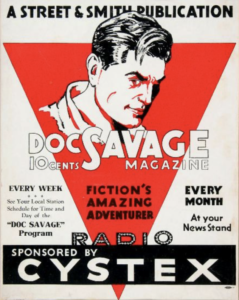
Throughout his pulp run, Doc evolved in accordance with successive editors and changing times.
Raised from the cradle by scientists and legendary mentors to become the pinnacle of human development, Doc’s father’s Übermensch-like vision for his son became increasingly awkward with the rise of Adolph Hitler and his plans for a “master race.”
As World War II approached and eventually encroached on Doc’s fictional world, Dent and company shifted away from globe-trotting adventures and fighting supervillains. Doc and his “brothers” began tackling Nazis and thwarting schemes to create superweapons that might tip the war effort in favor of the Axis.
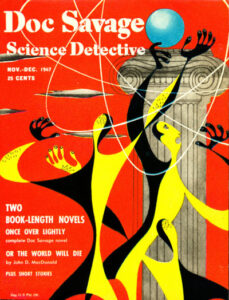 In 1944, Doc Savage was reduced in page count and its physical dimensions to a digest size. The publishing frequency of the title also began dwindling, shifting to bi-monthly, and at its end, quarterly status. It was even retitled Doc Savage Science Detective in 1947.
In 1944, Doc Savage was reduced in page count and its physical dimensions to a digest size. The publishing frequency of the title also began dwindling, shifting to bi-monthly, and at its end, quarterly status. It was even retitled Doc Savage Science Detective in 1947.
With the 1940s winding down and sales further plummeting, a final attempt was made to restore Doc Savage and The Shadow magazines to their former glory, going back to their original titles and restoring the title characters to the covers of their magazines in throw-back, 1930s-style covers by George Rozen.
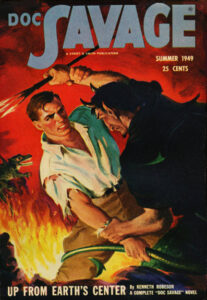 The last issue of Doc Savage appeared in 1949. In that strange final adventure that borders on the horror genre, Doc and his apish chemist aide, Monk, appear to literally journey to Hell — dubbed “Tophet” in the novelette. Written by Dent, the last of the original novels was entitled “Up from Earth’s Center.”
The last issue of Doc Savage appeared in 1949. In that strange final adventure that borders on the horror genre, Doc and his apish chemist aide, Monk, appear to literally journey to Hell — dubbed “Tophet” in the novelette. Written by Dent, the last of the original novels was entitled “Up from Earth’s Center.”
Lester Dent died in 1959 in his native Missouri, at the comparatively young age of 54. He passed a scant few years before his character’s pulp adventures returned to astonishingly sell millions of paperback reprintings. Between 1964 and 1990, Bantam Books reissued all of the original Doc Savage adventures. Following the conclusion of the reprints, the series was continued, first by Philip José Farmer, and later, by Will Murray. Nearly two-dozen additional adventures were published between 1991 and 2018, first by Bantam Books and later by Adventures in Bronze.
 In 1966, beginning with Gold Key Comics’ one-issue adaptation of “The Thousand-Headed Man,” Doc Savage returned to the comic book format. Marvel Comics, DC Comics, Millennium Publications, and others also tried their hand at a Doc Savage comic over the years.
In 1966, beginning with Gold Key Comics’ one-issue adaptation of “The Thousand-Headed Man,” Doc Savage returned to the comic book format. Marvel Comics, DC Comics, Millennium Publications, and others also tried their hand at a Doc Savage comic over the years.
In 1975, the character was featured in a rather campy and disappointing film helmed by the legendary George Pal and starring former TV “Tarzan” Ron Ely as Doc. In recent years, there have been reports of another Doc Savage movie or television series forthcoming.
Doc’s adventures were fully reprinted once again in the 21st Century by Sanctum Books, in 87 volumes. Sanctum’s run of reprints wrapped up in 2016.
Ninety years after he was introduced to readers during the Great Depression, Doc Savage continues to thrill and inspire. To learn more about Doc Savage, please subscribe to our YouTube Channel, where you’ll find our videos on Doc and other great pulp heroes, including Pat Savage, the first great pulp heroine. Click here to subscribe to our channel.
We hope you’ll join us at PulpFest 2023 as we celebrate the 90th anniversary of Doc Savage and other great pulp heroes. PulpFest 2023 will take place from August 3 – 6 at the DoubleTree by Hilton Hotel Pittsburgh – Cranberry in Mars, Pennsylvania. You can become a member of the convention by clicking the Registration button on the PulpFest website. And don’t forget to book a room.
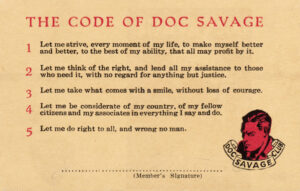 Craig McDonald is the author of the Edgar-nominated Hector Lassiter historical crime series which chronicles the exploits of a fictional Black Mask author. More recently, he has penned The Blood Ogre, a haunting mix of history and meta-fiction centered on the very act of literary creation. The first book in a planned series, introduces Zana O’Savin, Craig McDonald’s version of Doc Savage’s cousin Pat. Available in both hardcover and trade paperback from Amazon and other booksellers. It features front cover art by Chicago-based artist and illustrator Doug Klauba.
Craig McDonald is the author of the Edgar-nominated Hector Lassiter historical crime series which chronicles the exploits of a fictional Black Mask author. More recently, he has penned The Blood Ogre, a haunting mix of history and meta-fiction centered on the very act of literary creation. The first book in a planned series, introduces Zana O’Savin, Craig McDonald’s version of Doc Savage’s cousin Pat. Available in both hardcover and trade paperback from Amazon and other booksellers. It features front cover art by Chicago-based artist and illustrator Doug Klauba.
Our featured image is Walter M. Baumhofer’s front cover art for the March 1933 issue of Doc Savage Magazine, published by Street & Smith. Also pictured is Baumhofer’s front cover art for the second issue of the magazine, dated April 1933, illustrating “The Land of Terror.”
Paul Orban provided the generic interior illustration of Doc and his aides in their Manhattan offices, implied to occupy the 86th floor of the Empire State Building.
 No recordings of Doc Savage’s 1930s radio adventures are known to exist, however, the scripts have been gathered for various publications, including Moonstone’s 2009 volume.
No recordings of Doc Savage’s 1930s radio adventures are known to exist, however, the scripts have been gathered for various publications, including Moonstone’s 2009 volume.
Doc Savage Science Detective for November/December 1947 featured cover art by Walter Swenson. It’s one of seven issues of the Street & Smith magazine with that particular title. Beginning with the Winter 1949 issue, the magazine went back to the Doc Savage title.
Walter Swenson painted eleven Doc Savage covers from January 1947 through September 1948. The January/February 1948 number is a good example of his cover art. His interior illustrations can be found in some issues of John W. Campbell’s Astounding Science Fiction. They were also published by Street & Smith, right around the same time as his Doc Savage covers. Little more is known about the artist.
George Rozen painted the final Doc Savage cover for the Summer 1949 issue, illustrating the lead novel, “Up From Earth’s Center.”
The Man of Bronze, originally published in 1964, was the first of Bantam Books’ Doc Savage reprints. It featured the iconic James Bama version of Doc Savage.
For a couple of coupons clipped out of your Doc Savage pulps, you could become a member of the Doc Savage Club.

